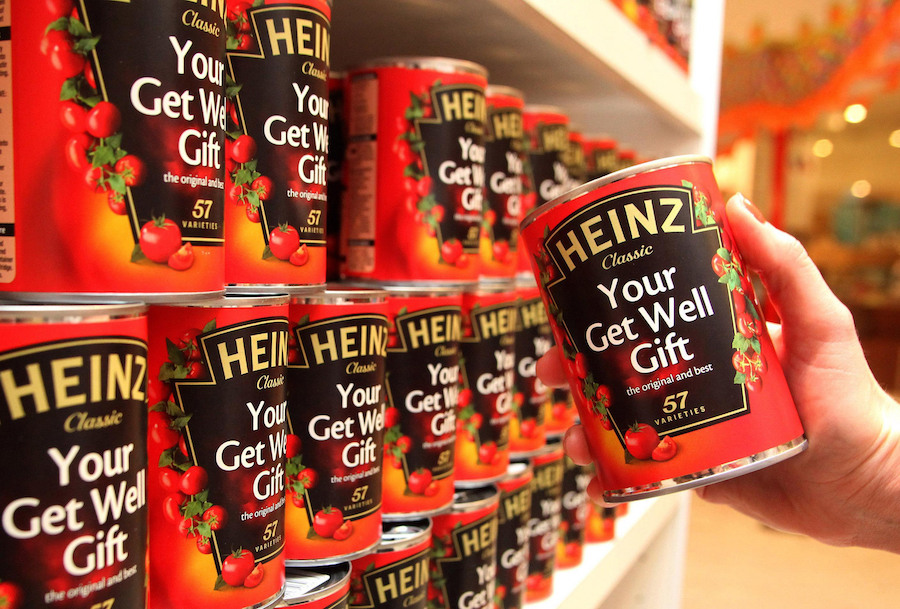Heinz at 150: Ketchup, the industrial revolution, and Joey from Friends
First up, a childhood-ruining revelation: There never were 57 varieties of Heinz. Up there with the 20th century’s most enduring marketing campaigns, the slogan was actually pinched by Henry John Heinz himself from an advert promoting ’21 varieties’ of shoes.
Reportedly, Heinz combined his and his wife’s lucky numbers to make 57 – ironically well short of the company’s already epic stock-list. Frankly, we’re still reeling from this discovery, so we’ll understand if you need a moment.
Recovered? Good – now let’s move on to cheerier thoughts.
View this post on InstagramWe know you’re grillin’…but how are you saucin’? #HeinzKetchup #HeinzMustard #HeinzMayonnaise
To celebrate 150 years of Heinz Ketchup, Beanz and Salad Cream, we combed through the back catalogue of one of the world’s most influential food companies…
A company of contrasts
A brand that tries to be all things to all men (and women, kids, grandmas, etc), Heinz has managed to span many of society’s divides.
Heinz products first hit UK stores in 1886, at the upmarket Fortnum & Mason, before rolling out mass-produced goods from UK-based factories shortly after. Whether by luck or by judgement – and received wisdom suggests it was the latter – Heinz became an unusually “classless” brand, stocking the fridges of Victorian gentlemen and factory workers alike.

“They never lost their initial association with luxury and quality,” says Polly Russell, food historian and curator at the British Library. “It’s a bit like Marks & Spencer today – the democratisation of quality.”
Hyper-aware of the power of the company image, salesmen reportedly had to be over 6ft, dress impeccably, and possess a large, elaborate vocabulary.
Nutritionally, Heinz similarly straddled the boundaries – core products that were healthy enough to be storeroom staples, but that still somehow felt like a bit of a treat. Generations of Heinz executives have meticulously guarded this ‘everybrand’ image, maintained with carefully calibrated ad campaigns.

Barely aged a day (Heinz/PA)
“Through the early-1900s, the emphasis was on factories and the poor, but then in the Thirties you have the ‘joy of living’ campaign, for that interwar period when people have more money and leisure time. They always keep the universal appeal: One advert will show children enjoying some baked beans, another a maid servant holding up some ketchup on a silver tray.”
In 1900, Heinz installed the first ever electronic ad sign in New York City – a 43ft, six-storey pickle on the site that now hosts the Flatiron Building. A 1970s TV ad with children reading Heinz-themed poetry scored big numbers with families, while their famous ‘Beanz Meanz Heinz’ slogan has been voted best ever by UK advertisers.
The cool factor
Heinz always seemed slightly ahead of the curve – never more so than in 1987, when a Ketchup commercial featured the screen debut of a fresh-faced Matt LeBlanc. In an ultra-urban setting, the future Friends star bounds down the stairs of an apartment building, just in time for his hastily-purchased hot dog to catch a drip of Ketchup falling from the roof above.
A classic of the genre, this featurette marks perhaps the most inexplicable dichotomy of all: Heinz, a food production company specialising in soups, sauces and vegetable products, was cool.
This may sound a stretch, but look at the evidence. The Who’s third album featured Roger Daltrey sitting in a bathtub of baked beans, with his arms wrapped round the can. During his tour of Ohio Ed Sheeren got the Heinz Ketchup logo tattooed into his arm, while punters queued in the streets outside Selfridges to pick up a limited-edition Beanz can in 2017. In the late-Nineties, Heinz products were approved by NASA for use in the International Space Station.
View this post on InstagramEd Sheeran has a ketchup tattoo. Somebody tell me how to feel about this.
Never content to be healthy or sugary, lavish or affordable, the Heinz marketing department always manages to have its beans and eat them.
It began with horseradish…
Of course, marketing is far easier when you have something worthwhile to sell, and founder-cum-namesake Henry John Heinz was as meticulous as he was forward-thinking.
An entrepreneurial success story, the company’s early years are soaked in the American dream. The son of first generation German immigrants, Heinz got his start selling horseradish to local businesses, from a small allotment in his home city of Pittsburgh. A consummate salesman, he was soon farming three-and-a-half acres of land and making about $2400 a year.
Right from the start, Heinz took the unusual step of selling products in clear glass jars, so consumers could see and judge quality for themselves. “This was an incredibly savvy move,” says Russell, “with the arrival of industrialised food production there was a huge amount of anxiety about food safety, and right at the beginning of the brand, there was an emphasis on freshness.”

Just a few of the forms adopted by the common or garden Ketchup bottle
Success happens when preparation meets opportunity, and Heinz’s hard work and business nous seized upon a key moment in food history. The industrial revolution had dragged thousands of workers into the cities – workers now reliant on complex food chains bringing sustenance in from the countryside.
“The consumer was divorced from the producer in a way that had never happened before,” says Russell. “Heinz and other manufacturers began making prepared food for a population without the land, facilities or time to eat in any other way. In this period, if you could do that in a way that was economic, safe and tasty, you could make quite a lot of money.”

Dame Edna Everage enjoying a classic British breakfast
He capitalised on the invention of the tin can, and then, in the 1890s, the rotary can opener – innovations that paved the way for a global food market that allowed his far-sighted vision to thrive.
Advances in steam technology meant that transporting across the Atlantic became commercially viable, because, unlike sailing ships, you could predict with a level of certainty when a steamer was likely to arrive.
Heinz did not re-invent the wheel, he just put it on the fastest car.
An edible ever-present
150 years on, Heinz sells 650 million bottles a year of Tomato Ketchup alone. The key to Heinz’s success has been continuity – its ketchup still uses the same, closely guarded recipe that it debuted with in 1876 – and many of its products have now been imbued with cultural significance.
In a rare PR blunder, Heinz announced in 2018 that they would be changing the name of Salad Cream to ‘Sandwich cream’, provoking a petition and bringing protesters out onto London’s streets. The small but dedicated band marched with T-shirts and placards reading, ‘Save our salad cream’, and, ‘Say no to sandwich cream’.

Rebels without a sauce
“Heinz is part of the repertoire of the ordinary kitchen,” says Russell. “People might have different brands, they might go cheaper, but if you ask them what brand they associate with those products, they’d still say Heinz.”
And for those still smarting from the ’57 varieties’ deception, direct your attention to the many giveaways Heinz has conducted over the years. In 1961, 57 competition winners received Mini cars, followed down the years by 57 holidays, 57 caravans, and so on. Imagine if Heinz and his wife had both had the lucky number two.
The Press Association
Latest posts by The Press Association (see all)
- 5 new books to read this week - November 23, 2024
- 3 easy Mary Berry recipes to make this season - November 22, 2024
- In Pictures: Party stalwart kept New Labour in touch with traditional supporters - November 21, 2024
- 6 easy indoor exercises to try this winter – and why they are good for you - November 19, 2024
- Martin Clunes: I can’t afford to retire – I’ve got too many horses - November 19, 2024





















